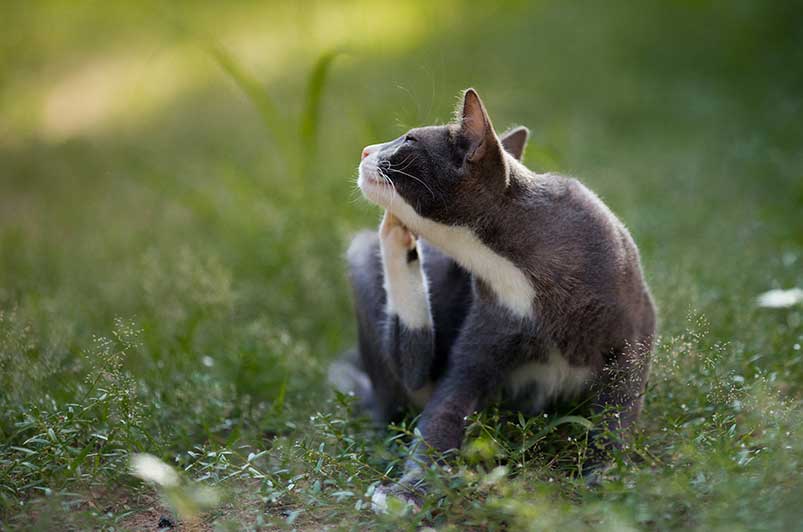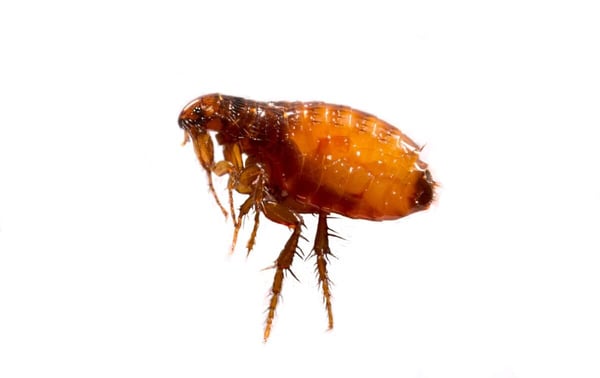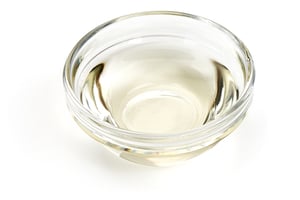
If your cat is itching more than usual, it could mean she has fleas! Read on to learn everything you need to know about fleas on cats and how to spot, treat, and prevent them.
Look what the cat dragged in… fleas. These tiny little nuisances can drive your cat and your family absolutely crazy!
Fleas are teeny tiny brown bugs that burrow into your cat’s fur to feast on his blood, causing mild to severe itching and discomfort. Without proper treatment, fleas can lead to other health issues in your cat, including anemia or tapeworms.
However, fleas can be difficult to detect on your super-hygiene-conscious feline. Being the mysterious creatures that they are, cats often do a great job at keeping their case of fleas a secret.
That’s why it’s extra important to know what to look out for and to take preventative measures to keep a flea infestation from occurring in the first place.
If you’re concerned your cat has fleas, the best thing to do is schedule an appointment with your veterinarian. Your vet will do a full examination and prescribe the proper treatment to solve the issue quickly.
This guide will walk you through everything you need to know about fleas on cats, from recognizing the signs to best practices for early prevention.
All About Fleas on Cats
 Fleas are external parasites, or ectoparasites, that feed on the blood of warm-blooded animals, including cats, dogs, birds and even humans! They are in no way ‘picky’ about who their host is, though humans are a more challenging target.
Fleas are external parasites, or ectoparasites, that feed on the blood of warm-blooded animals, including cats, dogs, birds and even humans! They are in no way ‘picky’ about who their host is, though humans are a more challenging target.
This means that your pets or wild animals are more likely targets of these opportunistic predators.
Scientifically named Siphonaptera, there are well over 2000 different species of fleas worldwide. In North America, there are only 7 species (thank goodness). The most common flea we encounter is the Ctenocephalides felis, more simply called the cat flea.
As the name suggests, cat fleas are the likely culprit if you suspect fleas on your cat!
While outdoor cats are the most vulnerable to flea infestations, indoor-only cats are still at risk of encountering fleas. As mentioned above, fleas aren’t particularly picky about whom they prey on, so they may hitchhike their way into your home on another pet or even you.
Not So Fun Facts About Cat Fleas
- Although fleas are but little, they are fierce! At only 1.8 to 2.5 millimetres in length, cat fleas are so small that it can take days before you spot them on your cat.
- Fleas have flattened bodies that enable them to move swiftly and discreetly through your pet’s fur. While you may not see them, you’ll definitely feel their impact!
- The bodies of cat fleas are covered in plates that protect them from scratching or biting – much to your pet’s dismay.
- Fleas are flightless insects, but this doesn’t mean they can’t make some major moves. Fleas can jump distances up to 50 times their size! That’s how they can jump from one pet to another.
- The life cycle of fleas goes through 4 phases: eggs, larvae, pupae, and adults.
- Female cat fleas can lay up to 1000s of offspring in their lifetime. Yes, you read that right! That’s why it is critical to catch them fast and early on. Flea eggs on cats might not stay there, which means your couch, bed, or your cats’ favourite lounge spots may be infested with eggs that eventually hatch into little brown bloodsuckers.
- The adult flea has two goals: find blood and reproduce! If it fails, it’ll only live for a few days. However, some adult fleas can live up to 2 months with enough food!
You can read more in-depth about fleas in our Ultimate Guide to Fleas on Dogs.
Fleas Spread Easily
.jpg?width=800&height=532&name=grey-tabby-scratching-ear%20(1).jpg)
All cats and all homes are prone to a flea infestation. Though inconvenient, it’s a natural part of life when living with pets. Even if you keep close tabs on where your tabby has been or take her in for regular grooming, there is always the possibility of fleas making their way into your household. It’s best to be prepared! How to get rid of flea eggs on cats?
If your cat has been diagnosed with fleas and you’re wondering where they could have come from, there are several ways your cat may have encountered fleas. Remember, fleas will feast on different types of animals. If you have other furry friends in the house, it’s possible the fleas were transferred from their backs to your cats!
Fleas might also use our clothing as a (free) Uber ride to their preferred host. You can usually tell if this happened if you have a few tiny bug bites on your arms or legs. Flea bites show up as small red dots and are often clustered in groups of two or three. If you notice flea bites on yourself, you definitely want to check your pets immediately!
Though you may end up with a few bug bites of your own, human bodies are no place for a flea to live its best life! They would much prefer to settle down in a warm coat of fur. Identifying the symptoms of flea bites on your cat is a skill every pet parent should learn!
5 Signs of Fleas on Cats
Early detection of fleas is critical to avoid a total cat-flea-tastrophe. But don’t worry! Spotting the signs of fleas is relatively easy as long as you’re an attentive cat parent.
Of course, the most obvious sign of fleas is live fleas and flea eggs on cats, but they are often hard to spot. Instead, look for some of these signs and symptoms of fleas and flea bites on cats.:
1. Scratching, Biting, and Licking

Fleas will burrow in and around your cat’s neck, ears, under their belly and their arms and start feasting away. If bugs crawling around the body weren’t irritating enough, flea bites on cats cause severe itchiness that will have your cat scratching, biting and licking the affected areas profusely.
2. Skin Problems and Hair Loss
A flea infestation can escalate quickly, forcing your cat into a scratching frenzy! This can often lead to loss of hair and other skin issues. If you notice these symptoms, you don’t want to hesitate in taking your cat to the vet for proper treatment.
They’ll also be able to rule out any other serious problems, such as Flea Allergy Dermatitis (FAD). This condition affects both pets and humans. It results from an allergic reaction to a flea’s saliva that causes an extremely itchy and painful rash.
3. Flea Dirt on Cats
One of the most obvious signs of fleas on cats (besides excessive scratching) is black specks of what appears to be dirt on your cat's fur or around your house. You might notice it left behind wherever your cat sleeps.
Commonly known as “flea dirt”, these little specks are actually the fleas’ feces. Because it is digested blood, it will have a red tint when wet. You can test this by placing the specks on a wet paper towel.
4. Lethargy and Pale Gums
When a flea infestation is left untreated for too long, it can lead to a more serious condition called anemia. This happens when the number of red blood cells being lost is greater than the number of new ones produced in your cat’s body.
While this can affect adult cats if fleas are not treated properly over a long period, anemia is more common in kittens due to their smaller size. Signs of anemia are lethargy and pale gums. If you notice these symptoms in your cat or kitten, head straight to the vet as soon as possible.
5. Tapeworms
As your cat bites and licks her body to relieve the itch, she may swallow a flea that is infected with tapeworm larvae. The larva then grows into an adult tapeworm in the intestines. Symptoms include fragments of the worm appearing in your cat’s stool.
Though it is an alarming sight to find little white worms coming out of your cat’s you-know-what, this is a common and relatively harmless side effect of fleas that can be easily treated by medication from the vet.
How to Get Rid of Fleas on Cats

So you’ve noticed your cat has been extra itchy lately, and you think he may be the victim of a tiny, blood-hungry pest. First step: keep calm. Next step: help your cat feel better!
Of course, scheduling a visit to the vet is the best plan of action, but it isn’t always possible right away. If the next available appointment isn’t until the next day and you want to offer your cat some instant relief, here is a play-by-play on how to get rid of treat fleas and which products work best.
3 Steps to Get Rid of Fleas on Cats
Fleas are annoying for both you and your cat, but once you've identified the fleas, they are fairly easy to get rid of. Just follow these simple steps to ditch these pests.
1. Treat Your Cat
The first and most important step is to treat your cat to rid them of these nasty little bugs. The sooner you start treating, the quicker you can ease your precious kitten's discomfort.
Comb the Fur
Combming your cat’s fur with a shedding comb will help remove some of the adult fleas and flea eggs. Keep an eye on any fleas that decide to jump ship! And be sure to rinse the comb in hot water with dish detergent to kill adult fleas and eggs left.
Bathe Your Cat
Next, it’s bath time! Bathe your cat thoroughly using a flea shampoo that’s safe for cats! Let the shampoo sit on her fur for at least 5 minutes. This will reveal and kill all of those stubborn fleas and eggs that the comb couldn’t reach!
Your cat might not be a fan of baths, but she’ll thank you afterward, as a good flea shampoo will quickly relieve the itchiness and resolve the issue.
Medicate
While bathing your cat may temporarily rid your cat of fleas, it’s important to give your cat preventative flea medicine to keep them from coming back, especially while you’re still clearing your home of the present infestation! We’ll touch more on the best flea medicines and how to prevent fleas on cats below.
2. Treat Your Home
With your cat freshly bathed and de-loused, you can tackle the larger issue at hand – your home. Wherever your cat sleeps, lounges or frequents around your house is likely also infested with fleas and eggs and must be deep cleaned.
Wash Bedding, Cushions, and Curtains
Anything you suspect has been affected by fleas, including your pet’s bedding, your own bedding, blankets, couch cushions, curtains or other cloth materials, needs to be washed in laundry detergent and hot water! Strip everything and toss it in the laundry.
It can take a few days to a week to rid your house completely of fleas, so you’ll want to routinely wash these items. For the household items you cannot strip and launder, apply a flea spray or powder regularly.
Vacuum, Vacuum, Vacuum
Next, you’ll want to vacuum every day for a few days to a week or whenever you can confidently say the infestation has cleared. Vacuum everything – carpets, hardwood floors, tiles, upholstered furniture, and dark crevices around your home where flea larvae and eggs could be hiding out!
Bring in a Professional
If you want complete peace of mind or if the infestation persists, bring in a professional exterminator to help you get to the bottom of your flea problem.
3. Treat Your Yard
Fleas can be difficult to prevent, especially if you have an outdoor cat or other animals that can carry them into your home. There are ways to keep fleas at bay if you have a yard while still allowing your animals to roam free.
Mow the Lawn Often
Keeping your lawn trimmed is one way to prevent a flea outbreak. Even if your cat is indoor-only, fleas can find their way back into your home on other pets or even you. Appropriate lawn care can limit
Hose it Down
Another way to keep fleas under control during the warmer months is to regularly hose down the areas in your yard that your pets frequent.
Spray the Perimeter
Use a flea yard spray to exterminate fleas around the perimeter of your home. Be sure to practice safety when using any type of bug spray, as they can be toxic to your pets. Using a pet-safe pest deterrent will be a better solution, especially if your cat has the luxury of playing outside.
How to Prevent Fleas on Cats
As mentioned above, prevention is key to keeping your cat safe from fleas and other pests. The best way to treat fleas on cats is with topical flea medicine administered monthly or tri-monthly, depending on the dose.
Talk to your vet about the best and safest preventative flea treatments for cats. Flea medications don't have to be
Remember: Only give your cat anti-flea medicine that is made for cats. Do not use anti-flea medicine for dogs as the ingredients are different and can cause a fatal reaction.
Flea collars are another way to prevent fleas. These collars will repel fleas from your cat’s neck and head. However, they may not be as effective for other areas of the body.
Flea sprays and powders are also important to keep on hand. Use these as a preventative measure for your pet’s usual sleeping areas.
Best Flea Treatments for Cats
Treating your cat's fleas is easy if you have the right pest treatment products. Here are some of our top picks for products to help you how to treat fleas on cats:
Elanco Advantage II Flea Treatment for Cats
Prevention is key! Elanco Advantage II Flea Treatment topical treatment offers your cat protection from fleas and other pests for up to one month.
It’s easy to apply and helps prevent a flea infestation. It begins working within 12 hours of application and works by killing fleas, flea eggs, and larvae instantly upon contact.
Zodiac Double Action Flea & Tick Shampoo
Made for both cats and dogs, this Zodiac Double Action Flea Shampoo is safe, gentle and effective in quickly killing fleas and offering your pets some relief from their discomfort. It works to fend off fleas and other pests for up to 4 weeks.
While your cat may not love bath time, this shampoo can help to provide fast relief from these annoying pests.
Thrive Diatomaceous Earth
For a flea powder to use around the house to actively eliminate fleas, try Thrive Diatomaceous Earth. This natural flea remedy works by scratching the exoskeleton of fleas when they crawl over it and causing them to dehydrate and die. It won’t stain your floors or furniture or harm your pets.
Find out more about how to properly use Diatomaceous Earth in this blog.
How to Get Rid of Fleas on Cats Naturally
Getting rid of fleas doesn't always have to involve harsh chemicals and insecticides. For cats with sensitive skin, you might be looking for a more natural approach to getting rid of fleas on your kitty.
Though many flea and tick treatments that kill pests and stop eggs from hatching are very effective, they do carry some risks. Common flea-killing ingredients, like permethrins, are highly toxic to cats. Products made for cats should be free of these toxic ingredients.
Natural remedies can be effective at pest control, too. Find out which natural ingredients you might have at home to help naturally solve your cat's annoying flea problems.
4 Best Home Remedies for Fleas on Cats
If you’re looking to learn how to get rid of fleas on cats naturally, several home remedies are safe to use. However, it’s important to keep in mind that homemade remedies for fleas on cats may not work for every pet.
Here are a few natural flea prevention alternatives to try:
1. Lemon

Does lemon kill fleas on cats? In fact, yes, it does! Citric acid is one of the more effective natural remedies for killing off and preventing fleas. Does lemon kill fleas on cats? For this reason, spraying your cat’s fur with diluted lemon juice is a widely known DIY method for treating your pet’s flea problem.
To make a lemon juice solution, start by boiling water with one to two cut lemons. Let the lemons steep in boiled water for a couple of hours. Next, drain the liquid and transfer it to a spray bottle.
Spray the solution and work it into your cat’s fur, avoiding the face and any open wounds. Be sure to monitor your cat’s reaction to the solution. Stop use immediately if signs of irritation occur.
2. Rosemary
Another natural way to prevent or eliminate fleas is by using spices you already have in your kitchen. Rosemary, for example, works as a natural flea repellent. Try grinding rosemary leaves into a powder and sprinkling it around your cat’s bed or favourite lounge spots to keep fleas away.
Be very careful about which herbs and spices you choose, though. Many common spices that deter fleas are also highly toxic to cats, like oregano.
3. Vinegar Solution

Fleas and other pests despise the smell/taste of vinegar, which makes it another natural remedy for treating fleas on your cat and in your home. Apple cider vinegar and white vinegar work to treat fleas.
To avoid irritation, dilute the vinegar with water before applying it to your pet’s fur. Vinegar is very strong, so aim for a 5-10% vinegar and water solution. This will make it safe to apply liberally and reduce the strong odour for you and your cat.
4. Coconut Oil
Coconut oil is one of the most natural all-around topical treatments for pets, and it can be a useful tool for preventing and treating fleas on your cat. Coconut oil applied topically will coat the fleas, limiting movement and suffocating the pests. Coconut oil to treat fleas on cats.
It's also great for soothing the itch and preventing infection from flea bites. If you wonder how to use coconut oil to kill fleas on cats, it's quite simple. Just massage a small amount of coconut oil onto your cat's fur, focusing more heavily on areas with flea activity.
You can use coconut oil as a pre-bath treatment for larger infestations to kill off the fleas and then wash them away.
These natural and homemade remedies may feel safer than some of the harsh chemicals used to kill off fleas and eggs in the store-bought solutions, but they are also often less effective.
There is no guarantee that these homemade solutions will fully protect your cat from fleas or other pests.
Treating Fleas on Kittens
Fleas don't care how young or old your cat is, and young kittens are unlikely to have had a preventative treatment, so it's not uncommon to find fleas in kittens.
Treating fleas on kittens can be a little different from treating adult cats. This is because not all medications or treatments are safe for your sensitive kitten's skin. If you suspect your kitten has fleas, the first thing you should do is contact your vet.
They will be able to help you choose the safest treatment for your baby ball of fur. If you are using a store-bought remedy or prevention method, check to make sure it's safe for kittens.
Elanco Advantage specifically states that it's safe for cats 8 weeks or older, while the Zodiac formula is approved for all ages.
Like the ones above, a natural option can be safer for young kittens for whom the standard chemical treatments are too harsh.
Keep Your Cat Flea Free

Fleas are, unfortunately, an inevitable reality that pet owners have to deal with at one point or another! And while it can be an absolute drag, treating the problem isn’t as difficult as you might expect. With proper attention and a quick response, you can learn to get rid of fleas on kittens fast.
Remember: prevention is key! Stay consistent with your cat’s routine treatments, especially during peak flea seasons. Decide on the right method for your cat, and be sure to start it at the first signs of warmer weather.
Now that you understand how to recognize the signs of fleas on cats, we advise that you add a regular flea check to your cat’s weekly routine.
While cats are excellent self-groomers, running a comb through their coats once or twice per week to check for fleas or other skin conditions is important to prevent an outbreak.
If you suspect your cat has fleas, talk to your vet to get a diagnosis as soon as possible to start treating the problem early. The fewer eggs laid, the faster the infestation can be remedied.
Call your vet if:
-
- You aren’t sure if your cat has fleas
- The treatments you are using aren't working
- Your cat has an adverse reaction
Frequently Asked Questions
Can cat fleas live on humans?
Cat fleas can bite humans and infest their clothing, but they typically prefer to live and reproduce on their primary host, which is cats.
Can cat fleas transmit diseases to cats and humans?
Yes, cat fleas can transmit diseases like Bartonella (cat scratch disease) to humans and other diseases to cats. Regular flea control is crucial to prevent the spread of diseases.
How can I tell if my cat has fleas?
If your cat is excessively scratching, biting, or grooming, and you notice tiny dark specks resembling pepper (flea dirt) on their fur, they might have fleas.
Do indoor cats get fleas?
Indoor cats can still get fleas if they come into contact with infested pets or environments. Fleas can be tracked into the house on other pets or even your clothing and make their way to their desired host.
Can cat fleas survive in my home?
Yes, cat fleas can lay eggs in carpets, bedding, and furniture, leading to a widespread infestation. Treating both your cat and their environment to effectively eliminate a flea infestation.
.png?width=200&height=66&name=logo%20(1).png)

